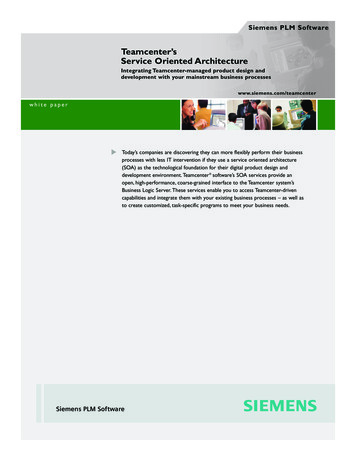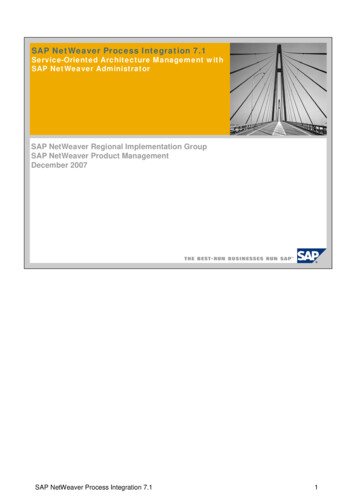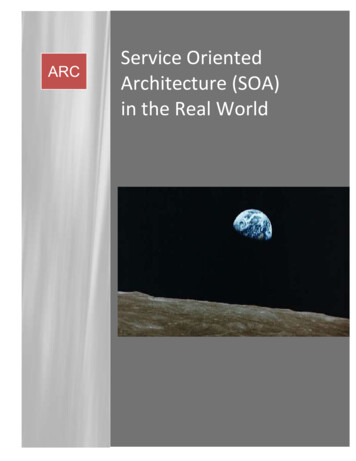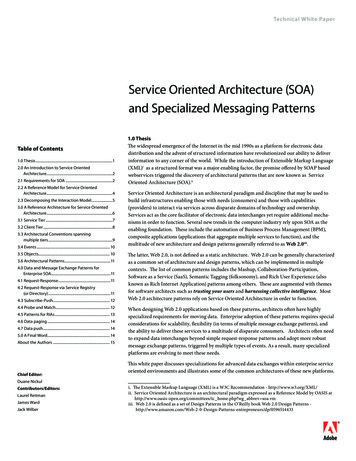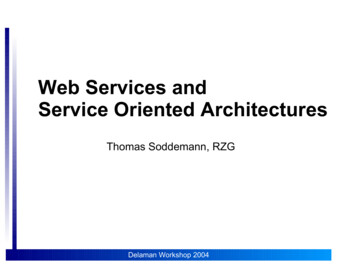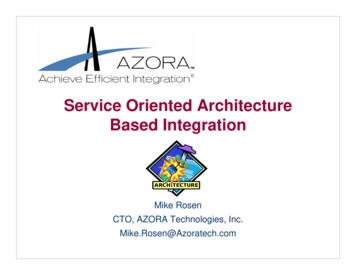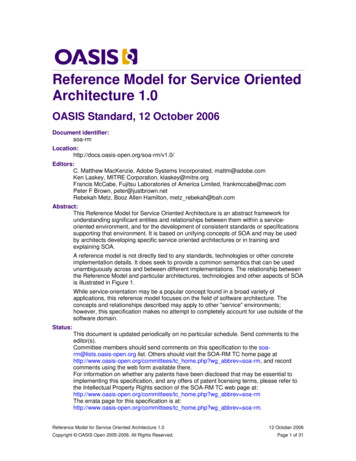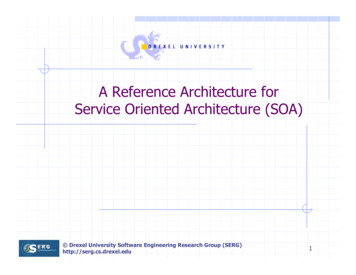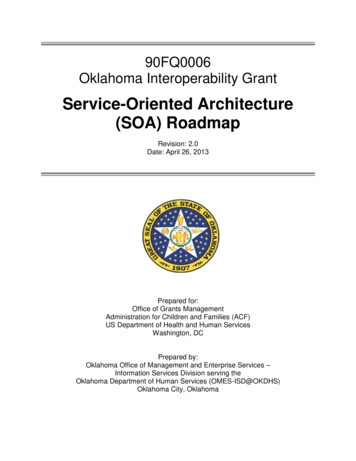
Transcription
90FQ0006Oklahoma Interoperability GrantService-Oriented Architecture(SOA) RoadmapRevision: 2.0Date: April 26, 2013Prepared for:Office of Grants ManagementAdministration for Children and Families (ACF)US Department of Health and Human ServicesWashington, DCPrepared by:Oklahoma Office of Management and Enterprise Services –Information Services Division serving theOklahoma Department of Human Services (OMES-ISD@OKDHS)Oklahoma City, Oklahoma
90FQ0006 - Oklahoma Interoperability Grant ProjectService-Oriented Architecture (SOA) Roadmap, Revision 2.0, April 26, 2013Approval SignatureSignature on File in Project FilesKaren Philbin, Project Team LeadSignature on File in Project FilesJames Conway, Project SponsorSignature on File in Project FilesAleta Seaman, OMES-ISD Director1
90FQ0006 Oklahoma Interoperability Grant ProjectService-Oriented Architecture (SOA) Roadmap, Revision 2.0 April 26, 2013Document Revision RecordDate04.26.2013RevisionRev. – 2.0POCKaren PhilbinSummary of ChangesEdits, additions and sequencing02.20.2013Rev. – 1.0Karen PhilbinInitial release of documentThe current version of this document is stored electronically within the OKDHS SourceControl System.2Copyright Oklahoma Department of Human Services 2013(Not for public disclosure unless otherwise approved)
90FQ0006 Oklahoma Interoperability Grant ProjectService-Oriented Architecture (SOA) Roadmap, Revision 2.0 April 26, 2013Table of Contents1Executive Summary . 61.1Purpose . 61.1.1Goals/Objectives . 61.1.2Project Outcomes . 71.2Assumptions and Constraints . 81.3Benefit to Other States . 91.4Breadth . 91.5Human Services Program and Initiatives. 91.6Information Technology Initiatives . 101.7Health Intersection. 111.8End Result . 111.9Background/Overview . 111.9.1Service-Oriented Architecture and Service-Oriented Systems . 121.9.2Services . 121.9.3Exploration Questions/Answers . 121.9.4Options Considered . 141.9.5Options Impact and Goals . 141.9.5.1 Improve service delivery for clients . 141.9.5.2 Reduce Errors and Improve Program Integrity . 151.9.5.3 Improve Administrative Efficiency . 152Architecture Frameworks . 152.12.22.32.4Building a(n) SOA Roadmap . 16National Human Services Interoperability Architecture (NHSIA) . 18Architecture Viewpoints . 19Implementing NHSIA . 243AS-IS OVERVIEW. 254Governance. 284.1AS-IS Governance. 294.1.1OKDHS – IT Governance Model. 294.1.2OHCA – IT Governance Model . 294.1.3OSDH – IT Governance Model . 304.1.4Overall Current Governance Structure. 304.1.5State of Oklahoma – Enterprise IT Governance Model . 315TO-BE SOA Strategy . 335.1TO-BE System Overview. 335.1.1Step 1: Define the SOA Reference Architecture . 345.1.2Step 2: Define the SOA Roadmap . 395.1.3Step 3: Define the Governance Strategy . 405.2TO-BE Security Requirements . 433Copyright Oklahoma Department of Human Services 2013(Not for public disclosure unless otherwise approved)
90FQ0006 Oklahoma Interoperability Grant ProjectService-Oriented Architecture (SOA) Roadmap, Revision 2.0 April 26, cies and Procedures . 45Web Services Security . 45Security for Web Services and Windows CommunicationFoundation (WCF) Services . 46Security for Databases. 46Exceptions . 47TO-BE SOA Interfaces . 47SOA and the Enterprise Service Bus (ESB) . 47Message Oriented Middleware (MOM) . 48TO-BE Web Services . 48Recommended Approach . 496.1The SOA Roadmap . 496.1.1Construct and Maintain Master Services Portfolio . 496.1.2Implement Cross Enterprise Security . 496.1.3Extend the Scope of SOA Solutions to Span Multiple Business Units . 506.1.4Extend the Scope of SOA Solutions to External Business Partners . 506.1.5SOA Communication and Update of Applicable Knowledge Portal . 506.1.6Develop Target Enterprise SOA Architecture . 516.1.7Specify SOA Policies and Procedures . 516.1.8Integrate SOA Principles into Organization Wide SDLC . 516.1.9Develop and Implement SOA Lifecycle Governance . 526.1.10 Summary of SOA Governance Strategy outlined earlier: . 526.1.11 Ensure Ongoing Partnership between IT and Business . 526.1.12 Ensure Executive Commitment and Sponsorship for SOA Program . 536.1.13 Provide SOA Training and Certification . 536.1.14 Monitor and Report on Service Performance . 536.1.15 Implement Services Using ESB . 536.1.16 Potential Sequence of SOA Initiatives . 536.2Summary . 547Acronyms . 55APPENDIX A – AS-IS SYSTEM INTERFACES . A-1APPENDIX B – AS-IS AGENCY PROGRAMS . B-1APPENDIX C – AS-IS SYSTEMS OVERVIEW . C-14Copyright Oklahoma Department of Human Services 2013(Not for public disclosure unless otherwise approved)
90FQ0006 Oklahoma Interoperability Grant ProjectService-Oriented Architecture (SOA) Roadmap, Revision 2.0 April 26, 2013List of TablesTable 1:Table 2:Table 3:Table 4:Table 5:Goals/Objectives . 7Project Outcomes . 7Exploration Questions/Answers. 12NHSIA and MITA Comparison. 21Web Services Security . 45List of FiguresFigure 1: Identify AS-IS and TO-BE . 16Figure 2: NHSIA Core Supports All Business Areas . 17Figure 3: Architecture Levels and Attributes. 19Figure 4: NHSIA Architecture Viewpoints . 20Figure 5: NHSIA Architecture Viewpoint Descriptions . 21Figure 6: NHSIA Provides a Framework for Shared Business Processes. 22Figure 7: Shared IT Infrastructure . 23Figure 8: Notional NHSIA Roadmap. 23Figure 9: Steps to Implement NHSIA . 25Figure 10: AS-IS System Overview . 26Figure 11: AS-IS System Overview/Data Exchanges . Error! Bookmark not defined.Figure 12: Current Governance Structure . 31Figure 13: Governance Structure . 32Figure 14: IT Governance Organizational Structure . 32Figure 15: IT Governance Organizational Structure . 33Figure 16: TO-BE Enterprise Architecture . 34Figure 17: SOA Reference Architecture . 35Figure 18: NHSIA Systems Reference Model Layers. 36Figure 19: SOA Governance IT and Enterprise Architecture Governance . 41Figure 20: SOA Governance with the Enterprise . 41Figure 21: Identity Management & Access Control . 44Figure 22: Potential SOA Initiative Sequence . 545Copyright Oklahoma Department of Human Services 2013(Not for public disclosure unless otherwise approved)
90FQ0006 Oklahoma Interoperability Grant ProjectService-Oriented Architecture (SOA) Roadmap, Revision 2.0 April 26, 20131 EXECUTIVE SUMMARY1.1 PurposeOklahoma is exploring and planning for improved interoperability and integration ineligibility and enrollment, case management, and other related functions across humanservices IT systems as well as exploring integration with other programs.This interoperability exploration and planning effort includes developing a roadmap forintegration of Service Oriented Architecture (SOA) and Enterprise Service Bus (ESB) toallow interoperability, fully automated data exchange and service reusability for allservices exchanged between Oklahoma Department of Human Services (OKDHS),Oklahoma Health Care Authority (OHCA), Oklahoma State Department of Health(OSDH) and other initiatives. In addition to the inter-agency interoperability initiatives,intra-agency initiatives for interoperability exist between three main business unitdivisions within OKDHS. These include Oklahoma Child Support Services (OCSS),Adult and Family Services (AFS) and Child Welfare Services (CWS).Currently OSDH is working independently on one interoperability plan, while OHCA isworking on another interoperability plan and now OKDHS, partnering with the Office ofManagement and Enterprise Services (OMES), is developing a third interoperabilityplan. These separate efforts are creating disjoined plans and possible inefficiencies.The intent is to come up with a unified overall interoperability plan that can improve dataexchange processes, increase data quality and reusability, reduce errors and enhancedata integrity between all the agencies.The purpose of this SOA Roadmap is to provide OKDHS and its collaborating agencieswith guidance regarding typical activities and initiatives that need to be executed as partof the SOA journey.This SOA roadmap will continually be updated as decisions are made and details arefurther defined.This project will provide opportunities for inter-agency collaboration and allow multipleState agencies to leverage SOA services and capabilities, in support of the state’s effortto meet the timelines of the Affordable Care Act (ACA) for citizen enrollment.1.1.1 Goals/ObjectivesThe major goals/objectives to be achieved with the implementation of the TO-BEsystem are summarized in Table 1.6Copyright Oklahoma Department of Human Services 2013(Not for public disclosure unless otherwise approved)
90FQ0006 Oklahoma Interoperability Grant ProjectService-Oriented Architecture (SOA) Roadmap, Revision 2.0 April 26, 2013Table 1: bilityReduce DataRedundancyGovernanceCostDesired OutcomeEnterprise widestandardsShared & reuseddataLess data redundancy& improved dataconsistencyPolicies andproceduresReduced operatingexpensesMeasurementAdopted by Inter/IntraAgencies and ProgramsAdopted as a model byother statesAdopted by Inter/IntraAgencies and ProgramsImpactImproved efficiencyAdopted by Inter/IntraAgencies and ProgramsLess operating andmaintenance costsConformance tostandardsConsolidatedmaintenance andshared operating costsImproved agility,response times,interoperabilityImproved agility,response times,interoperabilityImproved agility,response times,interoperabilityImproved agility,response times,interoperabilityShared Services InteroperabilityAdopted by Inter/IntraAgencies and ProgramsNHSIA adoptionInteroperabilityAdopted by Inter/IntraAgencies and ProgramsNIEM adoptionInteroperability anduse of standardsAdopted by Inter/IntraAgencies and ProgramsMITAcomplianceInteroperability anduse of standardsAdopted by Inter/IntraAgencies and ProgramsReduction ofdevelopment timeImproved data integrityand reduced errors1.1.2 Project OutcomesThe proposed interoperability plan provides the maximum potential for mutual benefitand “reusability” by health and human services organizations in Oklahoma, enabledthrough the Project Outcomes listed in Table 2.Table 2: Project OutcomesIndexO1O2Project OutcomesThis project provides opportunities for intra-agency and inter-agencycollaboration. It allows OKDHS and multiple State agencies to leverage SOAservices and capabilities, in support of the state’s effort to meet the timelines ofthe ACA for citizen enrollment. Leveraging SOA will provide for reusability andbetter data exchange to improve outcomes for vulnerable children and improveservice delivery for clients.The interoperability plan and SOA roadmap will outline compliance with theSeven Conditions and Standards as outlined by Centers for Medicare andMedicaid Services (CMS) and CMS Guidance for Exchange and MedicaidInformation Technology (IT) Systems Version 2.0. The Seven Conditions andStandards include:1. Modular Systems Development2. Align with MITA3. Industry Standards7Copyright Oklahoma Department of Human Services 2013(Not for public disclosure unless otherwise approved)
90FQ0006 Oklahoma Interoperability Grant ProjectService-Oriented Architecture (SOA) Roadmap, Revision 2.0 April 26, 2013O3O44. Share and Re-Use Technology (Leverage Condition)5. Deliver Business Results6. Performance Reporting7. InteroperabilityThe plan and roadmap will incorporate Medicaid Information TechnologyArchitecture (MITA) Maturity Model (MITA Framework Version 3.0) principles,National Human Services Interoperability Architecture (NHSIA) which provides acontext for standardized data sharing by incorporating the use of NationalInformation Exchange Model (NIEM), and SOA Integration Framework.Performance improvements can be realized through the development of businessprocesses, enabled by SOA, which can automatically perform eligibility validationand cross-referencing, as web services are enabled across the enterprise.Through the SOA roadmap, the development of business processes and thevalidation of web services to support these processes can transformadministrative activities to reduce redundancy of effort and streamline workflowsto improve efficiency.Develop a roadmap for integration of SOA/ESB to allow fully automated dataexchange and service reusability for all services exchanged between OKDHSand OHCA and other initiatives.1.2 Assumptions and ConstraintsAssumptions and constraints that influenced preparation of this document include: Schedule Constraints: Delayed start on Interoperability Planning Grant,scheduled contingent upon approval of SOA Roadmap.Data Constraints: To narrow and manage the project scope, the initial focus ison Eligibility and Enterprise Master Person Index (eMPI), and data exchangesbetween agencies and/or programs.Hardware Constraints: Any required hardware must fit with SOA and EnterpriseArchitecture and acquisition of any additional hardware is dependent on fundingor financial constraints.Software Constraints: Any required developed or Commercial off The Shelf(COTS) software must fit within the approved SOA and Enterprise Architecture,and acquisition of any additional software is dependent on funding or financialconstraint.Organizational Constraints: Resource acquisition and allocation may be afactor in implementing the Interoperability Plan. Policies and procedures may betoo specific to share or reuse for purposes other than eligibility.Security Constraints: Security mandates must be followed regarding thehandling of Internal Revenue Service (IRS), Health Insurance Portability andAccountability Act (HIPAA), Social Security Administration (SSA) and any federaltax information.Political Constraints: Local, state or federal laws or mandates may imposeconstraints.General Constraints: Federal funding streams earmarked to certain programswith attached restrictions and regulations create artificial silos creating barriers to8Copyright Oklahoma Department of Human Services 2013(Not for public disclosure unless otherwise approved)
90FQ0006 Oklahoma Interoperability Grant ProjectService-Oriented Architecture (SOA) Roadmap, Revision 2.0 April 26, 2013achieving interoperability across various human service organizations andprograms. In a sense, this barrier makes it difficult for certain organizations to“break out” of their current silos; although the Memorandum of Agreements(MOA) and Service Level Agreements (SLA) between organizations attempt tosolve some of these issues, this barrier is ever present based on the puremechanics. As implementation of the NHSIA Business Viewpoint strivesinteroperability through a functional point of view so must go the federal fundingstreams and associated restrictions and regulations if true interoperability is to bearchived.1.3 Benefit to Other StatesThis Interoperability Plan may be used by other states to implement EnterpriseInteroperability measures.1.4 BreadthThe focus of this interoperability effort will include: state and federal programs thatrequire eligibility determination: Supplemental Nutrition Assistance Program (SNAP),Temporary Assistance to Needy Families (TANF), Low Income Home EnergyAssistance Program (LIHEAP), Aid to the Aged, Blind and Disabled, and the child caresubsidy. Other human services programs that will benefit from a new configuration of ITservices include CWS, OCSS, Aging Services Division (Medicaid funded long term carewaiver) and Developmental Disabilities Services (Medicaid funded community basedwaivers). Other state agencies that are participating in the consortium include OHCA,Oklahoma Department of Mental Health and Substance Abuse Services and OSDH’sprogram; Women, Infants and Children (WIC). Other business segments involved inplanning include the Department of Public Safety and the State Department ofEducation.1.5 Human Services Program and InitiativesOKDHS is undertaking a multi-year, multi-program, agency-wide effort to update itstechnology, streamline and improve its business practices, consolidate its informationsystems, and provide a secure, compliant Web portal for OKDHS employees, clientsand providers to conduct daily business anytime, anywhere. OKDHS is pursuing anew Enterprise Software solution that is flexible and supports interoperability to allowinternal and external stakeholder’s access to the Enterprise System and data,regardless of technology. OKDHS is seeking an Enterprise Software solution that willincrease client use of self-service tools. The project will lead to a fully-functional,automated system that meets federal certification, compliance and mandates for childsupport, child welfare, and adult and family services and the associated titles andcertifications needed for certification.9Copyright Oklahoma Department of Human Services 2013(Not for public disclosure unless otherwise approved)
90FQ0006 Oklahoma Interoperability Grant ProjectService-Oriented Architecture (SOA) Roadmap, Revision 2.0 April 26, 20131.6 Information Technology InitiativesOKDHS is working with state governance and leadership to procure the software,installation and configuration for an enterprise human services application (HSA) tosupport the core business functions and processes of OKDHS, as described for theEnterprise System. Also, the OHCA is seeking to implement the technical aspects of theACA for Oklahoma. Many aspects of the OHCA plan are consistent with the approachenvisioned by the model. OHCA and OKDHS are working together on both of theirinitiatives to assure no duplication in funding or resources for similar projects using theMITA and NHSIA principles of re-usability. The proposed system will modernize existingsystem functionality to provide recipients a “golden standard” of customer care (i.e., aconsistent look and feel across stakeholders and seamless customer service withconsistent metrics to measure and continuously approve the customer experience). Theproposed system will also significantly enhance the ability for providers to have promptaccess to member eligibility and enrollment information to ensure that eligibleindividuals receive the health care benefits to which they are entitled and that providersare reimbursed promptly and efficiently.An individual seeking health coverage in 2014 will be able to access information andassistance, and apply for health coverage, through multiple channels. All of thesechannels will connect with a standardized, web-based system to evaluate theindividual’s eligibility for coverage through one of four programs: Qualified health plans through the Exchange (with or without Guidance forExchange and Medicaid Information Technology (IT) Systems 4 Version 2.0 May,2011/Centers for Medicare & Medicaid Services advance premium tax creditsand cost-sharing reductions)MedicaidChildren’s Health Insurance Program (CHIP)Basic Health Program, if established by the stateMITA ensures the availability of high-quality health care coverage to families andindividuals are achieved through a collaborative partnership between and within federalagencies and states responsible for implementation of the Exchanges and the ACA’sMedicaid and CHIP provisions.MITA envisions a streamlined, secure, and interactive customer experience that willmaximize automation and real-time adjudication while protecting privacy and personallyidentifiable information. Individuals will answer a defined and limited set of questions tobegin the process, supported by navigation tools and windows that open to provide orseek additional information based on individual preferences or answers.The application will allow an individual to accept or decline screening for financialassistance, and tailor the rest of the eligibility and enrollment process accordingly. Therequired verifications that will be necessary to validate the accuracy of informationsupplied by applicants will be managed in a standardized fashion, supported by a10Copyright Oklahoma Department of Human Services 2013(Not for public disclosure unless otherwise approved)
90FQ0006 Oklahoma Interoperability Grant ProjectService-Oriented Architecture (SOA) Roadmap, Revision 2.0 April 26, 2013common, federally managed data services hub that will supply information regardingcitizenship, immigration status, and federal tax information. Tools for calculation ofadvance premium tax credits will also be provided. Business rules will be supplied thatwill allow for resolution of most discrepancies through automation, includingexplanations of discrepancies for the consumer, opportunities to correct information orexplain discrepancies, and hierarchies to deal with conflicts based on source ofinformation and extent and impact of conflicts on eligibility. Individuals will attest to theaccuracy of the information they supply. The goal of MITA is to serve a high proportionof individuals seeking health coverage and financial support through this automatedprocess.1.7 Health IntersectionCurrently Oklahoma has elected to not participate in the Federal Health InsuranceExchange (HIE), nor have an Exchange. However, the OHCA will coordinate with theFederal Exchange in a yet to be determined process by conducting their own intakeprocess and determining eligibility.Additional Interoperability between NHSIA and MITA Programs for Oklahoma can bereviewed with Appendix A. Plans are to support a future exchange interoperabilityconcept.OSDH is seeking a comprehensive solution for an Interoperable Public HealthInformation System (IPHIS), to prepare for participating with health informationexchange activities and to improve the quality of data available to support decisionsabout improving the health of Oklahomans.1.8 End ResultInteroperability is the expected end result. Implementation of SOA/ESB under aNHSIA/MITA/NIEM framework guidance is the expected vehicle to achieveinteroperability. An eMPI is also an expected end result.1.9 Background/OverviewSOA has emerged as a crucial enabling technology for interoperability among disparatepieces of software regardless of the network architecture, platform, or programminglanguage. SOA is a conceptual framework for designing and building networks and Webservices that allow for data to be exchanged where and when it is needed. SOA is aclient/server design approach in which an application consists of software services andsoftware service consumers (also known as clients or service requesters).SOA differs from the more general client/server model in its definitive emphasis onloose coupling between software components, and in its use of separately standinginterfaces (Gartner). SOA raises the bar in terms of quality in service offerings. Services11Copyright Oklahoma Department of Human Services 2013(Not for public disclosure unless otherwise approved)
90FQ0006 Oklahoma Interoperability Grant ProjectService-Oriented Architecture (SOA) Roadmap, Revision 2.0 April 26, 2013are used by clients/partners, and implicit in their use is a trust – a trust that the servicewill be stable and always work as expected.SOA is an architectural approach to building systems which involves applicationsbeing exposed as “services”. This approach delivers two major values, sharingand agility. Sharing provides leverage and reuse. Agility provides the capability tochange more rapidly. SOA is accomplished through two fundamental principles:interface abstraction and modularization. There are five criteria for an SOAapplication: modular, distributed, discoverable, swappable, and shareable.From SEI – Carnegie Mellon1.9.1Service-Oriented Architecture and Service-Oriented SystemsSOA is a way of designing, developing, deploying, and managing systems, in whichservices provide reusable business functionality via well-defined interfaces. There is aclear separation between service interface and service implementation. Serviceconsumers are built using functionality from available services. An SOA infrastructureenables discovery, composition, and invocation of services. Protocols arepredominantly, but not exclusively, message-based document exchanges.From a more technical point of view, SOA is an architectural style or design paradigm; itis neither system architecture nor a complete sy
Service-Oriented Architecture (SOA) Roadmap . Revision: 2.0 . Date: April 26, 2013 . Prepared for: Office of Grants Management . Administration for Children and Families (ACF) US Department of Health and Human Services . Washington, DC . Prepared by: Oklahoma Office of Management and Enterp

